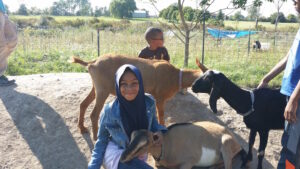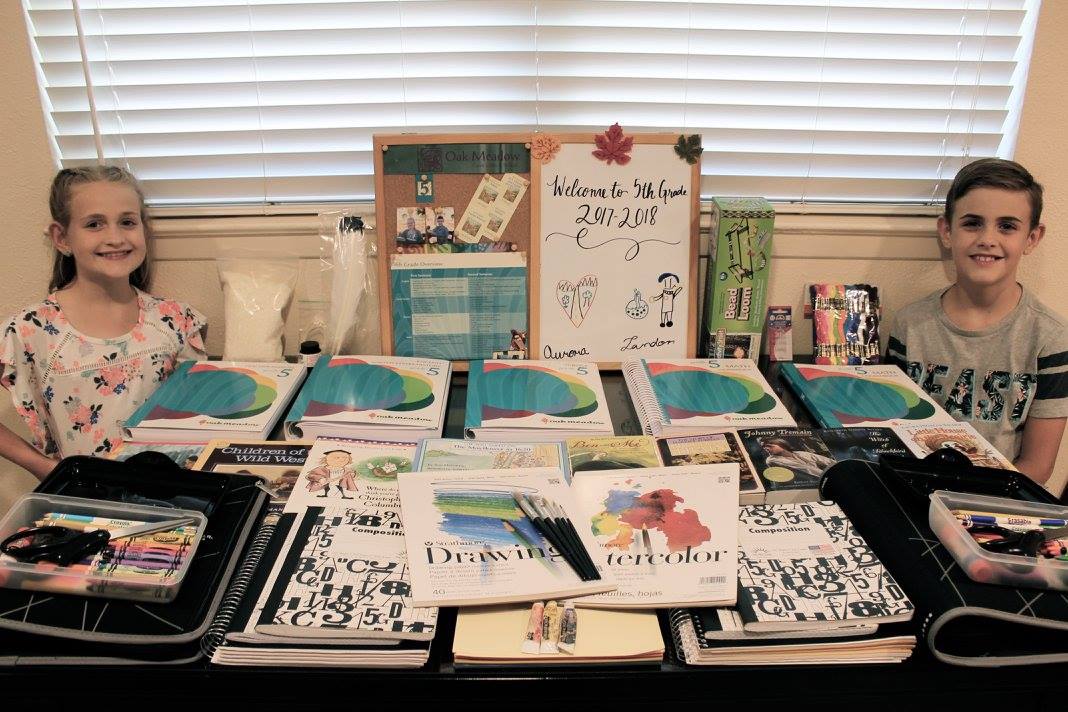The Oak Meadow homeschool curriculum provides students and families with an accessible, well-rounded, and academically complete education.
Oak Meadow offers secular, book-based, developmentally appropriate curriculum for preschool through high school.
Each of our curriculum coursebooks includes 36-weekly lesson plans, with a variety of assignments, activities, and readings. For the home teacher’s convenience, we’ve included assignment checklists, planners, materials lists, and learning assessment rubrics to track student progress. Many families enjoy the structure of our 36-week lesson plans, and others take advantage of the built-in flexibility of the curriculum design by adding, subtracting, or adjusting the material as needed or desired. Teacher guides, craft kits, and supplementary materials are available for further guidance and enrichment.
While Oak Meadow can be used as a comprehensive homeschool curriculum, many families choose to use our materials as their academic foundation and supplement them with other educational resources, or they purchase separate courses as part of an eclectic approach. Our K-4 coursebooks include lessons for all subject areas (note: Math is separate in Grade 4); grades 5-8 offer separate coursebooks for each subject and may be purchased individually; high school coursebooks are available by subject and course title.
If you’re homeschooling on your own, Oak Meadow’s PreK-12 curriculum is available for purchase in our online shop. And if you’re interested in enrolling in Oak Meadow School, your curriculum materials will be included with the price of tuition.
What makes Oak Meadow’s curriculum different?
Print-Based Materials
Our curriculum is print-based because we believe reading on paper encourages more effective comprehension skills than reading on a digital screen.
We use technology as a relevant tool for creativity, communication, and collaboration, but not primarily to deliver curriculum content. Especially in the early grades, the Oak Meadow curriculum can be completed without digital devices and internet connection; however, we thoughtfully and appropriately introduce technology throughout the grades. Leading research on learning and cognitive development shows that:
- Reading printed materials encourages active reading skills such as writing margin notes; highlighting key phrases and vocabulary; and noting questions, thoughts, and personal responses.
- Reading on screens drains mental resources and diminishes the brain’s ability to integrate information in the context of an entire text, thereby decreasing overall comprehension.
- Excessive screen time during adolescence reduces attention span, lowers executive functioning skills, and impairs relationship with adults and peers.
Enrolled families receive printed materials (digital versions are also provided for times when transporting books is inconvenient or prohibitive), but they communicate with their teachers online. Students in grades 7-12 work within the Oak Meadow domain using Google Apps for Education to exchange assignments, questions, and feedback; and for class discussions, interactive projects, and presentations.
Relationships
Our curriculum fosters caring relationships between students and home teachers.
Children are not just empty vessels waiting to be filled—they are intelligent, sensitive, creative beings eager to express all that they are inside. The key to releasing this innate intelligence lies in creating a caring, supportive relationship, for children—from preschoolers to teenagers—can only express their intelligence and sensitivity when they feel safe to do so.
Our support for home teachers includes:
- High quality teacher manuals
- Clearly stated learning objectives
- Easy-to-follow instructions and planners
- Easy-to-use assessment tools
- Meaningful assignments
- Helpful suggestions for creating a nurturing learning environment
Artistic Expression
Our curriculum provides opportunities for artistic expression.
A child needs to have opportunities for artistic expression. The form that this expression takes can vary widely; drawing, painting, music, poetry, woodworking, and more provide this opportunity. The main point to keep in mind is that the process is more important than the form. Forms that are created quickly with a minimum of inner focus are not as helpful to a child’s inner growth as forms that require persistent, focused awareness.
Here are examples:
- Recorder in the early grades
- Studio art through middle grades
- Art projects woven into academic subjects
- Detailed instructions for how to complete art and craft projects
- Exposure to many different artistic media
Inquiry and Problem Solving
Our curriculum encourages students to engage in authentic inquiry and creative problem solving skills.
It challenges them to think, explore, experiment, consider divergent views, and integrate knowledge gained in other subject areas. To help them learn how to solve complex problems, we ask them to form questions, make connections, and think logically in order to broaden their understanding. We want them to tackle the larger questions about the meaning and purpose of their lives, so they can make fulfilling life choices and authentic contributions.
In the curriculum, we present:
- Essential questions that encompass the themes of an entire year
- Guiding questions that help students make sense of individual units and lessons
- Discussion questions that spark debate
- Rigorous research projects that require students to explore topics in depth
- Exposure to primary source materials
- Reflection on problem solving strategies and results
Empathy
Our curriculum helps students develop empathy.
“All rapport, the root of caring, stems from emotional attunement, from the capacity for empathy. That capacity—the ability to know how another feels—comes into play in a vast array of life arenas, from sales and management to romance and parenting, to compassion and political action.” (Excerpted from Curriculum on the Edge of Survival by Dan Heller.)
The curriculum teaches empathy through:
- Exploration of characters in literature to try to understand motives and choices
- Close look at the lives of historical figures
- Practice writing and speaking from diverse points of view
- Experience debating both sides of an issue
- Opportunities to consider ethical questions
Hands-On Projects
Our curriculum provides opportunities for experiential learning through hands-on projects, experiments, civic engagement, and more.
Project-based learning is a dynamic approach to teaching in which students explore real-world problems and challenges, simultaneously developing crosscurriculum skills. Because project-based learning is filled with active and engaged learning, it inspires students to obtain a deeper knowledge of the subjects they’re studying. In the process of completing their projects, students also hone their organizational and research skills, develop better communication with their peers and adults, and often work within their community while seeing the positive effect of their work. (Excerpted from “Why Teach With Project-Based Learning?: Providing Students With a Well-Rounded Classroom Experience,” Edutopia.org.)
The curriculum includes:
- Plenty of opportunities for students to get their hands dirty—literally
- Opportunities for community-based and expeditionary learning
- Art projects that go beyond the craft kit
- Activities that require students to engage with unfamiliar materials
- Historical craft projects that limit use of modern materials
Self-Reflection
Our curriculum asks students to engage in self-reflection.
One way students become more independent is by reflecting on how they learn. Every person learns differently, and at a certain age, students can start paying attention to their own learning preferences or style. One of the simplest ways to examine one’s own learning style is by figuring out which activities are difficult and which ones are easy. From time to time, we ask students to reflect on their learning by writing about it or by discussing it with their home teachers.
- Learning reflections are assigned at regular intervals in every grade.
- Students are encouraged to choose their own writing topics.
- Meaningful self-assessments help students define what worked and what didn’t.
Understanding
Our curriculum helps students achieve genuine understanding.
To understand is to make connections and bind together our knowledge into something that makes sense of things. But the word also implies doing, not just a mental act. To understand is to be able to wisely and effectively use—transfer—what we know, in context; to apply knowledge and skill effectively, in realistic tasks and settings. When we understand, we have a fluent and fluid grasp, not a rigid, formulaic grasp based only on recall and ‘plugging in.’ (Excerpted from Understanding by Design by Grant Wiggins and Jay McTighe.)
We support student understanding with:
- Relevant projects that further students’ understanding of a topic or theme
- Connections built between course topics and with other subjects for fuller integration
- Authentic assessments that require students to apply new knowledge and skills in a practical way
- Clear learning objectives stated throughout the curriculum
Communication Skills
Our curriculum helps students improve their communication skills.
“Without communication, none of the other aspects of curriculum could exist, or if they did, they would be isolated phenomena. We are social animals and unless we can communicate our ideas, then we cease to be a community and become a collection of nonconnected entities.” (Excerpted from Curriculum on the Edge of Survival by Dan Heller.)
Various lessons require:
- Oral interviews and presentations
- Debates and group discussions
- One-on-one discussions
- Persuasive essays
Integrated Approach
Our curriculum takes an integrated approach to both academic learning and life experience.
 Frequently, education focuses on teaching facts; we believe that true education involves more than just the intellect—it engages and integrates every aspect of the human being and is intertwined with daily life.
Frequently, education focuses on teaching facts; we believe that true education involves more than just the intellect—it engages and integrates every aspect of the human being and is intertwined with daily life.
In addition to connections between school and life, Oak Meadow courses weave connections between disciplines. Science students use math in a practical way. Literature is used to illuminate historical time periods. Social studies courses incorporate art and culture. Literary analysis includes historical perspective. Art and health courses explore science and technology. Our integrated curriculum helps students connect disciplinary knowledge to their lives, the world they inhabit, and the world they would like to build through:
- Integration across subjects in relevant ways
- Project options that correlate to other subjects or individual areas of interest
- Community service opportunities that tie into curricular themes
Critical Thinking Skills
Our curriculum encourages students to use critical thinking skills.
A well-cultivated critical thinker:
- Raises vital questions and problems, formulating them clearly and precisely
- Gathers and assesses relevant information, using abstract ideas to interpret it effectively
- Comes to well-reasoned conclusions and solutions, testing them against relevant criteria and standards
- Thinks openmindedly within alternative systems of thought, recognizing and assessing assumptions, implications, and practical consequences
- Communicates effectively with others in figuring out solutions to complex problems
(Excerpted from “Our Concept and Definition of Critical Thinking,” Foundation for Critical Thinking.)
Oak Meadow’s curriculum encourages students to:
- Make predictions and connections
- Formulate well-reasoned arguments
- View issues from multiple perspectives
- Practice persuasive writing
- Solve challenging problems
- Consider practical, theoretical, and ethical issues
A World of Ideas
Our curriculum opens up a world of ideas based on a global perspective and local action.
Education is no longer about bringing students a world of information. It is about sharing with them a world of ideas: Eco-education. Social responsibility. Ethical considerations. Communication. Creative thought. Earth stewardship. Cultural heritage. Good citizenship. Media literacy. Sustainability. Life goals. These concepts form the foundation for meaningful academic studies.
Throughout our integrated curriculum:
- Connection to nature is integrated in multiple subjects
- Ethical skills are cultivated through relevant questions
- Global perspective guides cultural studies
- Environmental stewardship and sustainability is supported
Ready to learn more?
- View Curriculum Samples
- Discover our approach for grade level: Elementary, Middle School, and High School
- Attend a Virtual Info Session to learn more about using Oak Meadow’s curriculum independently and our distance learning school.
